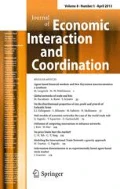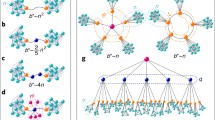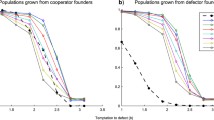Abstract
While studies on the emergence of cooperation on structured populations abound, only few of them have considered real social networks as the substrate on which individuals interact. As has been shown recently [Lozano et al., PLoS ONE 3(4):e1892, 2008], understanding cooperative behavior on social networks requires knowledge not only of their global (macroscopic) characteristic, but also a deep insight on their community (mesoscopic) structure. In this paper, we look at this problem from the viewpoint of the resilience of cooperation, in particular when there are directed exogenous attacks (insertion of pure defectors) at key locations in the network. We present results of agent-based simulations showing strong evidence that the resilience of social networks is crucially dependent on their community structure, ranging from no resilience to robust cooperative behavior. Our results have important implications for the understanding of how organizations work and can be used as a guide for organization design.
Similar content being viewed by others
References
Albert R, Jeong H, Barabási A-L (2000) Error and attack tolerance of complex networks. Nature 406: 378–382
Axelrod R (1984) The evolution of cooperation. Penguin, London
Axelrod R, Hamilton WD (1981) The evolution of cooperation. Science 211: 1390–1396
Boguñá M, Pastor-Satorras R, Díaz-Guilera A, Arenas A (2004) Models of social networks based on social distance attachment. Phys Rev E 70: 056122
Burt RS (1995) Structural holes: the social structure of competition, paper back edition. Harvard University Press, Cambridge
Camerer C (2003) Behavioral game theory: experiments in strategic interaction. Princeton University Press, Princeton
Chalub F, Santos FC, Pacheco JM (2006) The evolution of norms. J Theor Biol 241: 233–240
Chesbrough H (2003) Open innovation: the new imperative for creating and profiting from technology. Harvard Business School Press, Boston
Crespi BJ (2001) The evolution of social behavior in microorganisms. Trends Ecol Evol 16: 178–183
Danon L, Arenas A, Díaz-Guilera A (2008) Impact of community structure on information transfer. Phys Rev E 77: 036103
Duch J, Arenas A (2005) Community detection in complex networks using extremal optimization. Phys Rev E 72: 027104
Fontoura Costa L (2004) Reinforcing the resilience of complex networks. Phys Rev E 69: 066127
Granovetter M (1973) The strength of weak ties. Am J Soc 78: 1360–1380
Guimerá R, Danon L, Díaz-Guilera A, Giralt F, Arenas A (2003) Self-similar community structure in a network of human interactions. Phys Rev E 68: 065103
György S, Gábor F (2007) Evolutionary games on graphs. Phys Rep 446: 97–216
Kaza S, Xu J, Chen H (2005) Topological analysis of criminal activity networks in multiple jurisdictions. In: The National Conference on Digital Government Research, Atlanta, GA
Lozano S, Arenas A (2007) A model to test how diversity affects resilience in regional innovation networks. J Artif Soc Social Sim 10(4):8. http://jasss.soc.surrey.ac.uk/10/4/8.html
Lozano S, Arenas A, Sánchez A (2008) Mesoscopic structure conditions the emergence of cooperation on social networks. PLoS ONE 3(4):e1892. doi:10.1371/journal.pone.0001892
Newman MEJ (2003) The structure and function of complex networks. SIAM Rev 45: 167–256
Nowak MA (2006) Five rules for the evolution of cooperation. Science 314: 1560–1563
Nowak MA, May RM (1992) Evolutionary games and spatial chaos. Nature 359: 826–829
Poncela J, Gardenes JG, Floria LM, Moreno Y (2007) Robustness of cooperation in the evolutionary prisoner’s dilemma on complex networks. New J Phys 9: 184
Sagara H, Tanimoto J (2007) Analysis of impact of communication among different norms in norm reputation model. In: Proc. 11th Asia-Pacific Workshop on Intelligent Evolutionary Systems (CD-ROM)
Santos FC, Pacheco JM, Lenaerts T (2006) Evolutionary dynamics of social dilemmas in structured heterogeneous populations. Proc Natl Acad Sci 103: 3490–3494
Sugden R (2004) Economics of rights, co-operation and welfare, 2nd edn. Palgrave Macmillan, Hampshire
Wasserman S, Faust K (1994) Social network analysis: methods and applications. Cambridge University, Cambridge
Author information
Authors and Affiliations
Corresponding author
Additional information
This work was supported by Ministerio de Educación y Ciencia (Spain) under grants FIS2006-13321-2 and MOSAICO and by Comunidad de Madrid (Spain) under grant. SIMUMAT-CM. S. Lozano was supported by URV through a FPU grant and by the EU Integrated Project IRRIIS (027568).
Rights and permissions
About this article
Cite this article
Lozano, S., Arenas, A. & Sánchez, A. Community connectivity and heterogeneity: clues and insights on cooperation on social networks. J Econ Interact Coord 3, 183–199 (2008). https://doi.org/10.1007/s11403-008-0041-7
Published:
Issue Date:
DOI: https://doi.org/10.1007/s11403-008-0041-7




